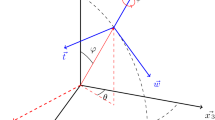Abstract
Offered in this work is the development of a macro/meso/micro model that covers the lineal scale of 10−11 to 100 by application of the volume energy density function. Boundary constraints and defect geometries are shown to play a role at the smaller scale in the same way as those at the macroscopic scale. Different orders of stress (or energy density) singularities are used to describe the defect geometry and prevailing constraint via the boundary conditions in a way similar to singularity adopted in classical fracture mechanics. Two classes of singularities have been identified in addition to classical one without violating the finiteness conditions of the local displacement and energy density. Still the connection of results from the different scales is no small task and is made possible by application of a scale multiplier. It is determined by considering the interactive effects of the parameters at the different scales from the atomic to the macroscopic. Unlike the classical boundary value problem approach, application of the scale multiplier has led to closed-form asymptotic multiscale solutions that otherwise would not have been made possible. The procedure is demonstrated for the anti-plane shear of a macro-micro-atomic model that accounts for imperfection at the different scales
Similar content being viewed by others
References
A. R. Leach, Molecular Modelling: Principles and Applications, 2nd edition, Prentice Hall, New York (2001).
P. W. Mast, G. E. Nash, J. Michopoulos, R. W. Thomas, R. Badaliance, and I. Wolock, “Characterization of strain induced damage in composites based on the dissipated energy density: Part I. Basic scheme and formulation; Part II. Composite specimens and naval structures; and Part III. General material constitutive relation,” J. Theor. Appl. Fract. Mech., 22(2), 71–125 (1995).
G. C. Sih, “Thermomechanics of solids: nonequilibrium and irreversibility,” J. Theor. Appl. Fract. Mech., 9(3), 175–198 (1988).
G. C. Sih, “Some basic problems in nonequilibrium thermomechanics,” in: S. Sienietyez and P. Salamon (eds.), Flow, Diffusion and Rate Processes, Taylor and Francis, New York (1992), pp. 218–247.
G. C. Sih and X. S. Tang, “Simultaneity of multiscaling for macro-meso-micro damage model represented by strong singularities,” J. Theor. Appl. Fract. Mech., 42(3) 199–225 (2004).
G. C. Sih and S. T. Tu, “Why, where and when it becomes necessary to consider chemical reaction effect in mechanics,” in: G. C. Sih, S. T. Tu, and Z. D. Wang, Fracture Mechanics and Applications: Structural Integrity and Aging, East China Univer. Sci. and Tech. Press (2003), pp. 1–19.
G. C. Sih, “Crack tip system for environment assisted failure of nuclear reactor alloys: multiscaling from atomic to macro via mesos,” J. Press. Equip. Syst., No. 3, 1–25 (2005).
G. C. Sih, Mechanics of Fracture Initiation and Propagation, Kluwer Acad. Publ., Boston (1991).
X. S. Tang and G. C. Sih, “Weak and strong singularities reflecting multiscale damage: micro-boundary conditions for free-free, fixed-fixed and free-fixed constraints,” J. Theor. Appl. Fract. Mech., 43(1), 5–62 (2005).
G. C. Sih and X. S. Tang, “Triple scale segmentation of non-equilibrium system simulated by macro-micro-atomic line model with mesoscopic transitions,” J. Theor. Appl. Fract. Mech., 44(2), 116–145 (2005).
G. C. Sih, “Introduction to series on mechanics of fracture,” in: Methods of Analysis and Solutions of Crack Problems: Recent Developments in Fracture Mechanics—Theory and Methods of Solving Crack Problems, 1, Noordhoff Int. Publ., Leyden (1973), pp. IX–XII.
G. C. Sih and X. S. Tang, “Dual scaling damage model associated with weak singularity for macroscopic crack possessing a micro/mesoscopic notch tip,” J. Theor. Appl. Fract. Mech., 42(1), 1–24 (2004).
G. C. Sih, “Implication of scaling hierarchy associated with nonequilibrium: field and particulate,” in: G. C. Sih and V. E. Panin (eds.), Prospects of Mesomechanics in the 21st Century, Special Issue of J. Theor. Appl. Fract. Mech., 37, 335–369 (2002).
Private Communication with S. M. Bruemmer On Chemistry and Microscopy of Intergranular Stress Corrosion Cracking in LWRs, Pacific Northwest National Laboratories (PNNL), June, Washington, USA (2005).
G. C. Sih, “Signatures of rapid energy movement of electrons in the valence band region: interdependence of position, time and temperature,” J. Theor. Appl. Fract. Mech., 45(1) (2002).
Author information
Authors and Affiliations
Additional information
Published in Prikladnaya Mekhanika, Vol. 42, No. 1, pp. 3–22, January 2006.
Rights and permissions
About this article
Cite this article
Sih, G.C. Multi-scale and multi-order singularity approach to non-equilibrium mechanics: Coupling of atomic-micro-macro damage. Int Appl Mech 42, 1–18 (2006). https://doi.org/10.1007/s10778-006-0054-7
Received:
Issue Date:
DOI: https://doi.org/10.1007/s10778-006-0054-7




